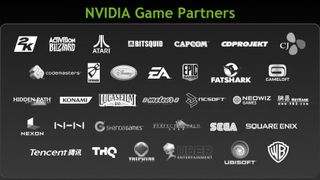How Nvidia Grid is set to revolutionise cloud gaming
Providing the backend technology for the cloud
"There's really not a download that has to happen, like a 1GB download that has to come down. It's an exciting opportunity for people that want to get their technology on any device."
Data centre density
Latency apart, Fear believes the biggest thing fighting cloud gaming is density. "When you think about other cloud gaming solutions that have come out, the challenge is to be able to serve out the maximum number of users per server – the number of concurrent users, or CCUs.
"We look at a server and ask if we're utilising everything to the max because a telco – Vodafone, Orange or whoever – wants to maximise a server because [they're] paying for space in a server room, power and air conditioning. Those are your costs.
"We stack as many Grid servers into a rack as possible and stream out as many games at once as possible." Indeed, the Grid system is provided in a standard server rack, which can house up to 20 servers per rack. That in turn equates to a whopping 240 GeForce Kepler GPUs and can cater for up to 7,200 subscribers.

The whole architecture is scalable. For high end games there can be a ratio of one subscriber to a single virtual GPU (vGPU), whereas for casual games, there can be four subscribers per vGPU. It's completely up to the reseller as to how they want to use the servers. Nvidia reckons that means around 48 HD quality gamers per server.
Fear admits that many of the subscription services powered by Nvidia Grid won't have the latest games, but he sees this as an opportunity rather than a threat, especially at a time when casual tablet and smartphone gaming is becoming increasingly important. "So there are the hardcore gamers from 18-35 who are the target market for most console gaming and also PC gaming.
"But what they find is that pretty soon you get out of that age bracket or your priorities change, they have children, they have a full time job that doesn't afford them the time to game until 3am.
Are you a pro? Subscribe to our newsletter
Sign up to the TechRadar Pro newsletter to get all the top news, opinion, features and guidance your business needs to succeed!
"They still consider themselves a hardcore gamer, but a subscription is a great model for them. They may well be willing to spend $20-$25 a month to get access to a library of games. They might be six months old but frankly you don't care, you were too busy to start playing them when they first came out."

As Fear points out, it's only a matter of time before it's accepted that games are just another cloud service in much the same way as we've come to welcome and rely on Netflix and Spotify for other forms of entertainment.
Dan (Twitter, Google+) is TechRadar's Former Deputy Editor and is now in charge at our sister site T3.com. Covering all things computing, internet and mobile he's a seasoned regular at major tech shows such as CES, IFA and Mobile World Congress. Dan has also been a tech expert for many outlets including BBC Radio 4, 5Live and the World Service, The Sun and ITV News.
Most Popular

